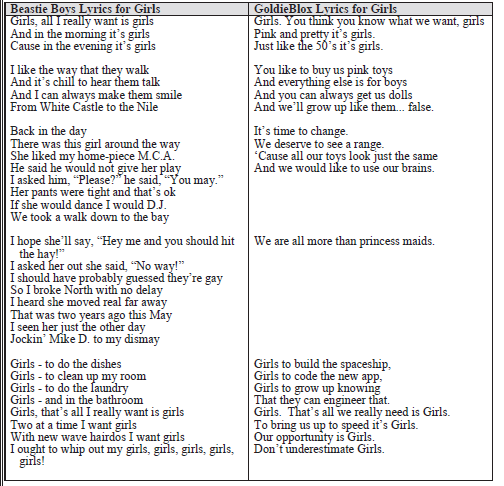After GoldieBlox announced with great fanfare that it would withdraw its claim seeking a declaratory judgment that its use in a video of the Beastie Boys song “Girls” was a fair use under the Copyright Act, many assumed that was the end of it and that the only point for discussion was GoldieBlox’s motivation. As we pointed out at the time, however, that “offer” was not accompanied by a dismissal of the already filed lawsuit. Presumably, the Beastie Boys either declined, or failed to respond, because the band has now answered the Complaint and filed counterclaims, alleging copyright and trademark infringement.
Nicholas O'Donnell

Recent Posts
Now who’s rapping like it’s a commercial? The Beastie Boys counterclaim against GoldieBlox Web advertisement
Topics: Cariou v. Prince, Copyright Act, Campbell v. Acuff Rose Music Inc., Green Day, Michael Diamond, Adam Yauch, “Girls”, GoldieBlox, Copyright, Adam Horowitz, Beastie Boys, Fair Use
327 Gurlitt Collection Works Now Known; Time for Claims in the United States?
The coordination office in Magdeburg continues to post details about works of art seized from Cornelius Gurlitt in Schwabing, with a total of 327 works now available for viewing. There has been almost no discussion yet, however, of what process the government will employ to allow claimants to make their case. Those in the United States have options discussed further below.
Topics: veschollene Kunst, Schwabinger Kunstfund Cornelius Gurlitt, Strafprozessordnung, Hildebrand Gurlitt, EBS Dispute Resolution Center, Munich Hoard, IFKUR, Verjährungsfrist, Peter Bert, Germany, Matthias Weller, prescriptive ownership, Nazi-looted art, Gurlitt Collection, Foreign Sovereign Immunities Act, Baden-Württemberg, Entartete Kunst, Nazis, Ingeborg Berggreen-Merkel, Munich, Schwabing, Magdeburg, FSIA, Dispute Resolution in Germany, Bavaria, Looted Art, Foreign Sovereign Immunities, deutches Recht, degenerate art, Altmann v. Republic of Austria, www.lostart.de, stop, Raubkunst, German Civil Code § 221, Sec. 108 German Code of Criminal Procedure, Kunstfund München, Münchner Kunstfund
Post Eligibility Ruling, Kevyn Orr Reiterates Expectation That DIA will Contribute Revenue to City’s Financial Plan
Just after the Bankruptcy Court held that Detroit is indeed eligible for Chapter 9 bankruptcy, Emergency Manager Kevyn Orr reiterated that he expects the Detroit Institute of Arts to contribute financially to the city’s plan to emerge from insolvency. Said Orr, “We’d like to find a way to monetize the DIA.”
Topics: DIA collection sale, Detroit, Detroit Institute of Arts, DIA, Kevyn Orr, Detroit Bankruptcy
Detroit Institute of Arts Responds Swiftly to Detroit Bankruptcy Eligibility Ruling
The Detroit Institute of Arts was ready: the museum released a statement immediately after the Bankruptcy Court's ruling today that Detroit is eligible for Chapter 9 Bankruptcy (in which specific reference to the DIA collection was made). As we expected, DIA took aim at last week's creditors, and make clear its vehement objection to the capitalization of the museum's collection. The statement reads:
Topics: DIA collection sale, Detroit, Detroit Institute of Arts, Detroit Bankruptcy
Detroit Bankruptcy Will Proceed, Judge’s Comments about Detroit Institute of Arts Could Affect Involvement or Sale of Artwork
The Hon. Steven W. Rhodes of the U.S. District Court for the Eastern District of Michigan has ruled that Detroit may proceed with its Chapter 9 bankruptcy. Judge Rhodes explained his ruling for over an hour from the bench, finding Chapter 9 itself to be constitutional, and addressing other challenges including the requirements of Michigan state law, whether the city had bargained in good faith, and the extent to which pensions could be cut in the eventual plan to emerge from bankruptcy. The written decision is not yet available, but check back later in the day and it will be posted here.
Topics: kevyn, DIA collection sale, Steven W. Rhodes, U.S. District Court for the Eastern District of Mi, Christie's, Detroit, Detroit Institute of Arts, DIA, Detroit Bankruptcy
GoldieBlox Declares a Truce with the Beastie Boys, What was That All About?
After the skirmish over whether GoldieBlox's video featuring the melody and parodied lyrics of "Girls" by the Beastie Boys was fair use or infringement, the company abruptly altered the video in question on its website. The same video is now accompanied by different music. The company also issued the following statement on its blog:
Topics: “Girls”, GoldieBlox, Copyright, Beastie Boys, Fair Use
Detroit Creditors Press Bankruptcy Court for Action on Sale of Detroit Institute of Arts Collection, Motion Likely Premature and Unfounded
Major creditors of the city of Detroit filed a request in the bankruptcy proceeding to hasten the process of evaluating the value of the collection of the Detroit Institute of Arts. The motion raises a few questions, but fundamentally it is off-base: in a municipal bankruptcy the creditors are never going to be able to force the sale of DIA's art. It will ultimately be, as it has always been, the decision of the city through its emergency manager Kevyn Orr. Significantly, though, this is the first actual filing in the bankruptcy related to DIA.
Topics: Syncora Guarantee Inc., NORD/LB Covered Finance Bank S.A., City of Detroit Retirees, 11 U.S.C. § 904, Syncora Capital Assurance Inc., Dexia Crédit Local, FMS-WM Service, Christie's, valuation, Ambac Assurance Corporation, Appraisal, Detroit, Detroit Institute of Arts, Bankruptcy, FMS Wertmanagement, DIA, Erste Europäische Pfandbrief-und Kommunalkreditban, Hypothekenbank Frankfurt International S.A., Dexia Holdings, Michigan Council 25 of the American Federation of, AFL-CIO and Sub-Chapter 98, Kevyn Orr, Hypothekenbank Frankfurt AG, Financial Guaranty Insurance Company, Detroit Bankruptcy, National Association
GoldieBlox Parodies the Beastie Boys and “Girls”—Fair Use is Clear, What About Queen’s “Bohemian Rhapsody”?
Coverage has exploded this week of a dispute between the Beastie Boys and a company called “GoldieBlox,” over the latter’s use of the song “Girls” in a video encouraging engineering and structural play toys for girls. Despite coverage focusing on whether Goldie Box copied the Beastie Boys’ song (which is undisputed, really, and thus beside the the point in this case), the fair use of the earlier song is clear: the new version is a parody of a leering anthem, intended to subvert inherent sexism into a message of empowerment. Curiously, however, the fair use in another video on the company’s site using the Queen song “Bohemian Rhapsody” seems less clear, but so far unnoticed.
Topics: License to Ill, Copyright Act, Campbell v. Acuff-Rose Music, Queen, Digital Millennium Copyright Act, DMCA, Adam Yauch, “Bohemian Rhapsody”, “Girls”, GoldieBlox, Copyright, MCA, Beastie Boys, Fair Use
5Pointz Not of "Recognized Stature" Under the Visual Artists Rights Act? Court Takes the Narrow View and Paintings are Whitewashed
Amidst all the coverage over famed graffiti artist Banksy’s recent "residence" in New York and questions about how artistic license would fare against trespassing and graffiti laws (short answer: poorly), another graffiti case in New York this month has explored the reach of the Visual Artists Rights Act of 1990 (VARA). Ultimately, the law did not suffice to prevent the owner of the so-called "graffiti Mecca" from proceeding with its intended use of the property (and obliteration of the graffiti).
Topics: Carter v. Helmsley-Spear, Copyright Act, Inc., Graffiti Art, Visual Artists Rights Act, recognized stature, VARA, Jerry Wolkoff, Banksy, 17 U.S.C. § 106A, Erin Thompson, Copyright, 5Pointz, Litigation
The Auctioneer is the Agent of the Seller in Every Auction: Buyer Gets the Better of Argument in Jenack Appeal Oral Argument. Are Auction Houses Ready if Result Stands?
The New York Court of Appeals held oral argument last week in the appeal from the Appellate Division of the New York Supreme Court’s ruling in Jenack v. Rabizadeh that an auctioneer must disclose the name of any owner who has consigned the work for sale, or a sale against a successful bidder cannot be enforced consistent with New York General Obligations law § 5-701, the New York Statute of Frauds (video in Windows Player). The court actively questioned both sides before taking the case under advisement. The view here is that the buyer (Rabizadeh) got the better of the argument, but one has to wonder how the equities will weigh on the court in a case where the winning bidder simply repudiated a voluntary transaction.
Topics: Legislation, New York General Obligations Law § 5-701, § 5-701(a)(6), Auctions, Jenack v. Rabizadeh, New York Court of Appeals, Ivan Petrovich Khlebnikov, Fine Russian Silver/Enamel Covered Box with Gilt I, New York Supreme Court, Chester, Statute of Frauds, 12 Wend. 548, William J. Jenack, Uniform Commercial Code, Hicks v. Wigmore




